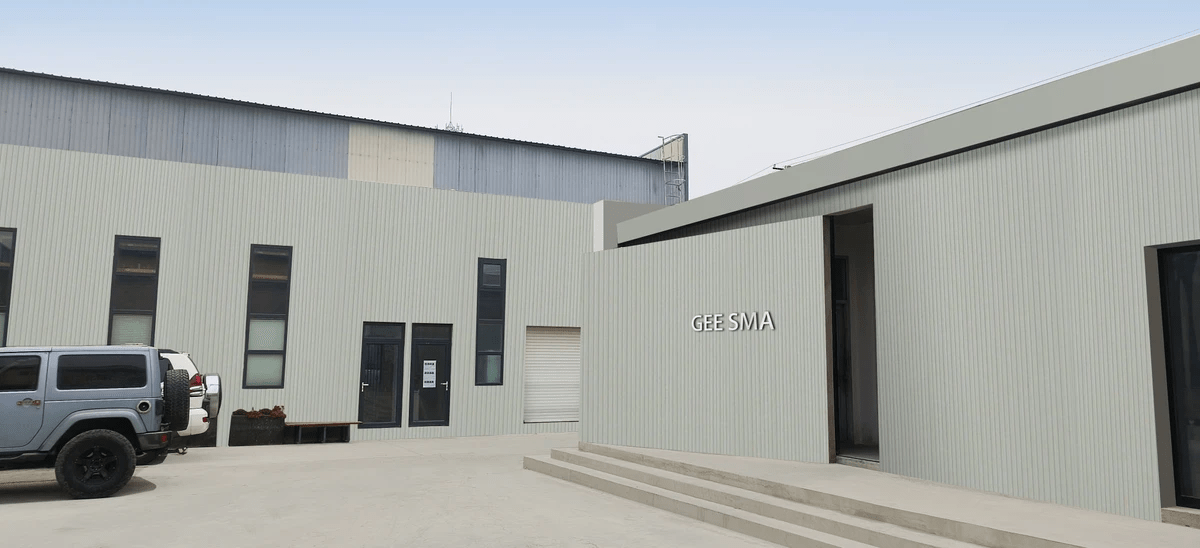Introduction

Nitinol, short for nickel-titanium naval ordnance laboratory, is a remarkable material with unique properties that have revolutionized various industries. From its shape memory effect to superelasticity, Nitinol has become a game-changer in Medical Materials Inc. and beyond. This introduction will delve into this memory metal's basics, applications, and properties, shedding light on its endless possibilities.
Understanding the Basics of Nitinol
What does Nitinol stand for? The name itself is a combination of its elemental composition—nickel (Ni) and titanium (Ti)—and its place of discovery at the Naval Ordnance Laboratory (NOL). With an impressive melting point of around 1310°C, Nitinol exhibits a fascinating ability to return to a predetermined shape when heated above this temperature.
Nitinol's unique properties have made it a valuable material in various industries, including medical devices, aerospace, and robotics. Due to its shape memory and superelasticity, Nitinol is often used in stents, orthodontic wires, and other implants in the medical field. Its ability to return to its original shape after deformation makes it an ideal material for minimally invasive medical procedures. Nitinol's lightweight yet durable nature in aerospace and robotics makes it suitable for applications such as actuators and sensors, contributing to advancements in technology and engineering.
Exploring the Applications of Nitinol
Nitinol's applications are vast and diverse, ranging from biomedical devices like stents and guidewires to aerospace engineering components such as actuators and sensors. Its unique properties also make it an ideal material for consumer goods like eyeglass frames and cell phone antennas.
Unveiling the Properties of Nitinol
Nitinol is a remarkable material boasting several exceptional properties:
- Shape Memory Effect: It can return to its original shape after deformation, making it highly versatile across industries.
- Superelasticity: This property enables it to withstand extreme conditions without breaking.
- Impressive Fatigue Resistance: Nitinol can endure repeated stress cycles, ensuring long-term performance.
These unique characteristics make Nitinol a standout choice for applications demanding resilience and adaptability. Its ability to "remember" its original shape and spring back to form is a game-changer, opening doors to innovative product designs. Moreover, its toughness in harsh environments solidifies its reputation as a top-tier material for demanding applications.
What Does Nitinol Stand For?

The Origin and Meaning of Nitinol
Nitinol, a remarkable alloy, derives its name from its composition of Nickel (Ni), Titanium (Ti), and Naval Ordnance Laboratory (NOL), where it was first discovered in 1961. This unique combination gives Nitinol extraordinary shape memory and superelastic properties, making it a highly sought-after material in various industries.
Nitinol's shape memory and superelastic properties are the result of its unique atomic structure, which allows it to return to its original shape after being deformed simply by being heated. This remarkable ability has led to Nitinol's use in a wide range of applications, from medical devices such as stents and orthodontic wires to actuators and robotics. The alloy's ability to withstand repeated deformation without permanent damage makes it invaluable for industries requiring durable and reliable components.
Nitinol: The Shape Memory Alloy
Nitinol is often called memory metal due to its ability to return to a predetermined shape when heated. This remarkable characteristic has led to innovative medical devices such as stents, orthodontic wires, and guidewires that can be inserted into the body compactly before expanding to their original inside shape.
Nitinol's unique properties have also revolutionized minimally invasive surgical procedures, allowing for more precise and less invasive treatments. For example, using Nitinol-based catheters has made it easy to navigate through complex blood vessels, reducing the risk of damage and improving patient outcomes. Nitinol's biocompatibility and corrosion resistance make it an ideal material for long-term implantation in the human body, ensuring the safety and efficacy of medical devices made from this shape memory alloy.
Nitinol: A Miracle Material in Medical Science
With its biocompatibility, corrosion resistance, and unique mechanical properties, Nitinol has revolutionized the field of medical materials, Inc. It is widely used in minimally invasive surgical instruments and implants, enabling groundbreaking advancements in patient care and treatment outcomes.
Nitinol's versatility extends beyond surgical instruments and implants. It is also used in medical devices such as stents, guidewires, and orthodontic wires. Its shape memory properties allow these devices to adapt to the body's natural movements and changes, providing patients with more effective and comfortable treatment options. Additionally, Nitinol's superelasticity makes it ideal for applications requiring flexibility and durability, further expanding its use in various medical procedures.
The Versatile Applications of Nitinol

Nitinol, also known as memory metal, has found its way into various applications across various industries. From biomedical devices to aerospace engineering and even consumer goods, nitinol's versatility is truly remarkable.
Nitinol in Biomedical Devices
Nitinol's unique properties make it an ideal material for biomedical devices such as stents and guidewires. Its superelasticity allows these devices to withstand the rigors of the human body without losing their shape, while its impressive fatigue resistance ensures long-lasting performance. Nitinol's biocompatibility makes it a safe choice for implantable medical devices, reducing the risk of adverse patient reactions. The material's ability to adapt to the body's temperature changes further enhances its suitability for biomedical applications, making it a versatile and reliable option for medical device manufacturers.
Nitinol in Aerospace Engineering
Due to its unique properties, nitinol, a shape memory alloy, has become an indispensable material in aerospace engineering. It excels in components demanding precise shape memory and an exceptional strength-to-weight ratio.
Here’s why nitinol is a prime choice for aerospace applications:
- Shape Memory Effect: Nitinol can return to its original shape after deforming, making it perfect for actuators and deployable structures in space missions.
- Corrosion Resistance: Nitinol’s resistance to corrosion ensures the longevity of components exposed to harsh environments.
- High Fatigue Endurance: This property allows nitinol to maintain its shape memory and functionality even after repeated use in demanding conditions.
These characteristics make nitinol a crucial material for enhancing the reliability and durability of spacecraft and satellites. As aerospace technology continues to evolve, nitinol's potential to revolutionize the industry remains promising.
Nitinol in Consumer Goods
From eyeglass frames to orthodontic wires, nitinol is making its mark in consumer goods due to its flexibility and durability. Its shape memory effect allows for innovative designs that adapt to users' needs while maintaining their original form.
With its remarkable properties and endless potential applications, it's no wonder that nitinol remains at the forefront of material innovation across various industries. Whether it's revolutionizing medical treatments or enhancing the performance of aerospace components, nitinol is truly a game-changer in the world of materials science.
Unveiling the Properties of Nitinol

Nitinol, also known as memory metal, is a remarkable alloy with a unique shape memory effect. When deformed at lower temperatures, it can return to its original shape when heated. This property makes it ideal for applications in medical devices, such as stents and orthodontic wires, where precise shape memory is crucial.
Nitinol's Unique Shape Memory Effect
Nitinol's remarkable shape memory effect stems from its ability to undergo a reversible phase transformation between austenite and martensite. This means it can remember and return to its original shape after significant deformation.
Nitinol's applications are vast and groundbreaking.
- Medical Industry: It has revolutionized minimally invasive procedures.
- Aerospace: Its shape memory properties are invaluable in aerospace components.
- Automotive: It enhances vehicle performance and safety.
- Consumer Goods: From eyewear to self-adjusting fabrics, nitinol improves product functionality.
This versatile material has opened doors to innovative solutions across industries, making it a game-changer.
Nitinol's potential is far from exhausted, promising even more exciting developments in the future.
Nitinol's Superelasticity
In addition to its remarkable shape memory effect, nitinol's superelasticity also allows it to maintain its structural integrity even after undergoing large deformations. This unique property makes it an ideal material for critical aerospace engineering applications, where extreme conditions and high-stress levels are common. By withstanding such conditions without permanent damage, nitinol ensures that the performance of aerospace components remains uncompromised, contributing to the overall safety and reliability of aircraft and spacecraft.
Nitinol's Impressive Fatigue Resistance
Nitinol's impressive fatigue resistance makes it suitable for long-term use in various applications. Its ability to withstand repeated loading and unloading cycles without failure has made it a top choice for critical consumer goods and industrial equipment components.
With its unique properties and versatile applications, nitinol continues to push the boundaries of what is possible in various industries. As the demand for advanced materials grows, the future of nitinol looks promising, with endless possibilities waiting to be explored.
Partnering with GEE SMA provides access to custom nitinol solutions that meet specific requirements across different sectors. Whether developing innovative medical devices or enhancing aerospace technologies, GEE SMA is committed to delivering high-quality nitinol products tailored to individual needs and specifications.
The Future of Nitinol in Various Industries

Nitinol, also known as memory metal, has revolutionized various industries with its unique properties and versatile applications. From biomedical devices to aerospace engineering, the possibilities with Nitinol are truly endless.
Exploring the Endless Possibilities with Nitinol
Nitinol's remarkable shape memory effect and superelasticity have opened up a world of possibilities in engineering and design. Its ability to return to a predetermined shape after deformation makes it an ideal material for intricate medical devices and innovative consumer goods.
Nitinol's unique properties have also revolutionized the aerospace industry, where its lightweight and durable nature makes it an ideal material for components in aircraft and spacecraft. The ability of Nitinol to withstand extreme temperatures and return to its original shape after being subjected to stress or strain has made it a game-changer in aerospace engineering. From intricate mechanisms to structural components, Nitinol has proven to be a versatile and reliable material for the future of aerospace technology.
As technology advances, the demand for Nitinol is expected to soar across industries. Its impressive fatigue resistance and high melting point make it a frontrunner for future aerospace, automotive, and even robotics applications. With its shape memory and superelasticity properties, Nitinol has the potential to revolutionize medical devices, such as stents and orthodontic wires, providing enhanced patient care and treatment options. Additionally, the unique ability of Nitinol to return to its original shape after deformation makes it an ideal material for actuators in consumer electronics and smart devices, paving the way for innovative gadgets and products in the market.
Partnering with GEE SMA for Custom Nitinol Solutions
For businesses looking to harness the power of Nitinol, partnering with GEE SMA for custom solutions is the key to unlocking its full potential. With expertise in shaping this miraculous material into tailor-made products, GEE SMA is paving the way for groundbreaking innovations.
Partnering with GEE SMA for custom Nitinol solutions means gaining access to a team of experienced engineers and designers dedicated to pushing the boundaries of what is possible with this remarkable material. By collaborating closely with clients, GEE SMA ensures that each custom solution meets the specific needs and requirements of the project, resulting in truly innovative and effective products. With a focus on precision and quality, GEE SMA is committed to delivering custom Nitinol solutions that exceed expectations and drive success.

